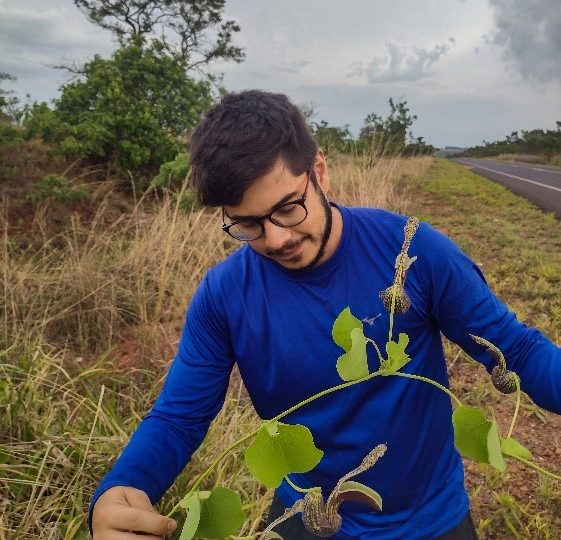In this new post Carlos Matallana-Puerto, PhD candidate at Universidade Estadual de Campinas (Brazil), presents his work ‘Sex, flies, and flower trap: trapping trichomes and their function in pollination’. He talks about the importance of overlooked traits, shares some tricks for using cotton in research, and encourages young ecologists to move abroad to pursue their research path.
A Spanish translation of this blog post is available here
About the paper
It is well known that in animal-pollinated plants, floral traits related to attraction, reward, and flower-pollinator fit can influence plant mating and fitness through the removal and deposition of pollen. However, other less-studied floral traits can also promote pollen transfer between plants, such as microstructures in the floral whorls. Flowers or inflorescences specialized in temporarily trapping their pollinators inside chambers have evolved independently several times in Angiosperms. These “trap flowers” exhibit various epidermal microstructures that make their surfaces slippery, facilitating the capture while hindering the escape of pollinators. This is the case with the trapping trichomes present in the deceptive trap flowers of some Aristolochia (Aristolochiaceae) and Ceropegia (Apocynaceae) species, which have long been suggested to play a crucial role in the pollination of these flowers.
We used the trap flowers of the South American Aristolochia esperanzae to experimentally test the importance of trapping trichomes in the reproduction of trap flowers. We demonstrated for the first time that the presence of the trapping trichomes increases the entrapment of pollinators, consequently enhancing pollen removal and fruit set. This is because, while the erect trapping trichomes ensured the entrapment of pollinators and hindered their escape, the wilting of these trichomes after pollen was deposited on the pollinators facilitated their release, allowing the pollen to be transported to other flowers. In this way, our study broadens the perspective to include other, less-studied floral traits that can also influence plant mating and fitness, such as the epidermal microstructures of flowers.
About the research
Based on the salutary effect of trapping trichomes on the male and female pollination performances of trap flowers, we suggest that the evolution and maintenance of this floral trait likely occur through selection pressures exerted by both sexual functions as well as from pollinator groups. Thus, trap flowers may be viewed as general examples of selection pressures and the evolution of traits that can optimize plant mating and reproduction. Perhaps analogous to animal and even human reproductive behaviors, deceptions and subterfuges involved in trapping insects for pollination may be selected if they increase fitness.
One of the challenges in our study was figuring out how to remove the trapping trichomes from the flowers. After brainstorming many far-fetched ideas, we were surprised to find that the hairs could be removed using cotton swabs, causing no harm to the flowers. Nevertheless, not all trap flowers of angiosperms have trapping trichomes. Some other microstructures perform similar roles related to the capture and entrapment of pollinators, such as ornamented and moist cell surfaces. Therefore, the next steps include designing experiments to test the influence and effectiveness of these other traits in the functioning of trap flower pollination. Additionally, further studies are needed to understand how pollinator-mediated selection occurs in these floral traits of trap flowers.
About The Author
My interest in ecology, particularly plant ecology, began as a child, as I come from a farming family in Duitama, Boyacá, Colombia. My mother’s family cultivated food crops, while my father’s family lived in rural areas. I remember always being curious about nature, animals, and plants. Thus, I chose biology as an academic career. I studied biology at the Universidad Pedagógica y Tecnológica de Colombia (UPTC) in Tunja, Boyacá, Colombia, where my interest in botany grew, particularly in plant pollination and reproduction.
During my undergraduate studies at this university, I began working with Professor Liliana Rosero Lasprilla, who I consider my greatest scientific inspiration. Along the way, I became fascinated with orchids and Aristolochias, groups that captivated me with their fascinating flowers and highly specialised deceptive pollination systems. Since then, I have decided to study the pollination and reproductive systems of these plants. During my master’s degree, which I pursued in the Postgraduate Program in Plant Biology at the Universidade Estadual de Campinas (UNICAMP) in Brazil, I decided to study pre- and post-pollination strategies that may promote outcrossing in the deceptive trap flowers of Aristolochia. This research resulted in the first evidence of a late-acting self-incompatibility system for the family Aristolochiaceae, and the current study on trapping trichomes. Currently, I am pursuing my PhD studies in the same institution in Brazil, under the supervision of João C. F. Cardoso and Paulo E. Oliveira. In my doctoral thesis, I continue to explore aspects of the ecology and evolution of trap flowers.
Unlike countries in the global north, Latin American countries face different research and scientist training challenges. In my case, as a white man who had access to primary and university education in Colombia, my obstacles are more related to not being a native English speaker and the lack of funding. For example, during my undergraduate studies in Colombia, all my research was self-funded, with the support of my family and research group professor. Because of this, I decided to pursue my postgraduate studies in Brazil, one of the Latin American countries that invests the most in education, science, and technology. As advice to people starting their scientific careers, particularly those from countries with less investment in science, I recommend seeking funding opportunities for research or scholarships at institutions in other countries. This will allow them to continue conducting research without being forced to leave science due to a lack of opportunities in their home countries.
Like the blog post? Read the research article here.
Leave a comment






